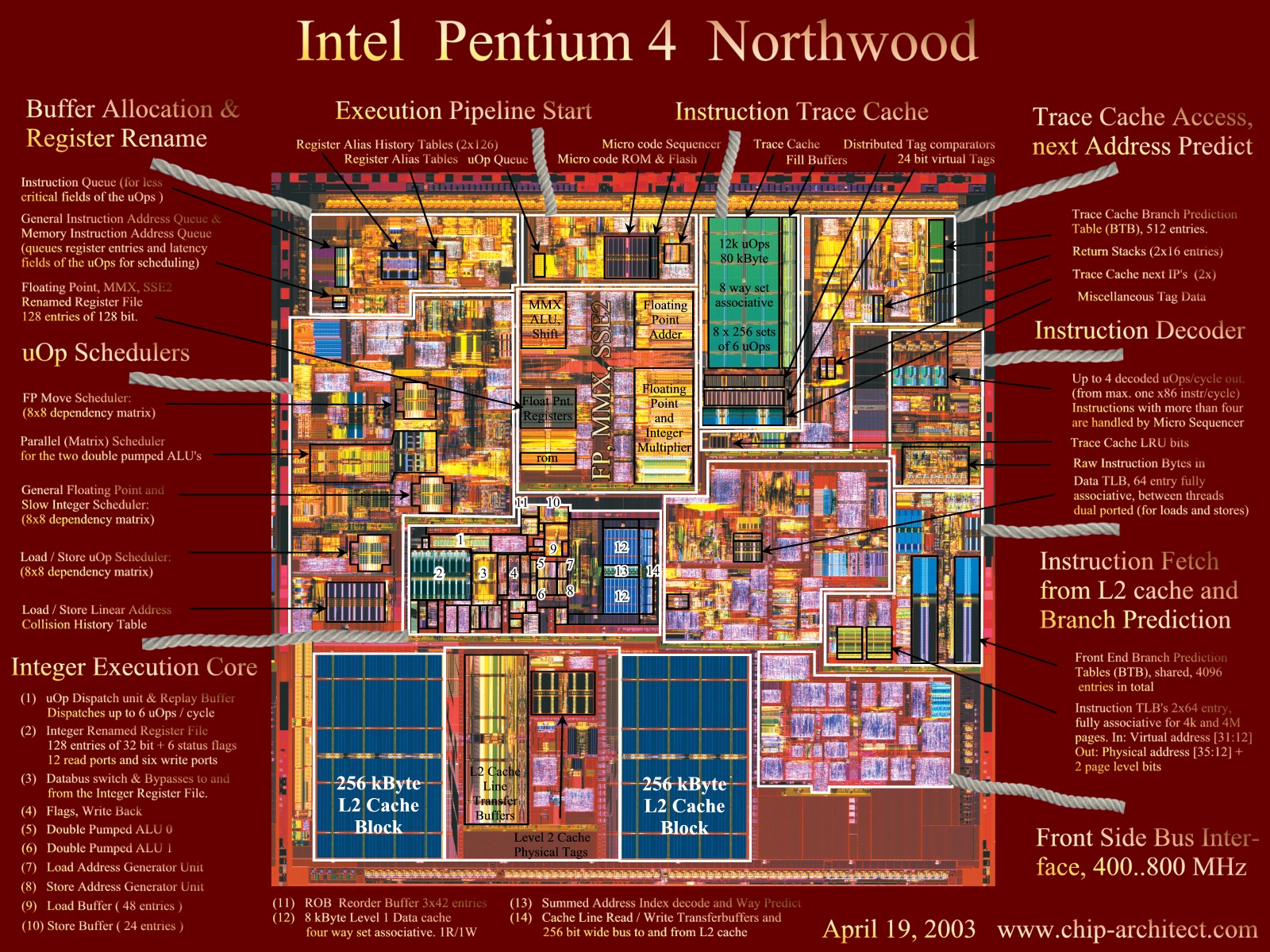Means they're all hard-coded, no microcode layer slowing things down. Only 3 bits needed to specify the instruction (though I bet they use 4). It's a really nice chip.
Yeah, so the microcode layer is not slowing things down in modern CPUs, even if they have a complex instruction set - the overwhelming majority of instructions are hard-coded there as well, with microcode only executing system level functionality or obsolete instructions these days. It's not an intermediate layer anymore, but an exception mechanism with very little direct cost.
But your overall conclusion is nevertheless correct: Tesla has a huge chip design advantage by using just 8 instructions.
This advantage that Tesla has with its extremely simplified instruction set can be best understood by looking at an older CPU architecture from ~15 years ago where the internal die layout is known already:
(Current CPUs will have a similar execution architecture but much larger caches - and there are no public annotated die diagrams.)
The important takeaway from that annotated image of the Intel CPU die is the part marked "Integer Execution Core" and "FP, MMX, SSE2" block marked right above it, in the center of the chip.
Those two central areas are the
REAL CPU that calculate things and make programs progress. All the other bits: the "Execution Pipeline Start", "Instruction Trace Cache", "Address Predict", "Instruction Decoder", "Branch Prediction", "Buffer Allocation & Register Rename" areas are a consequence of trying to make a historically complex and poorly designed instruction set go fast, and these complications are
entirely missing from Tesla's chip.
This is one of the little understood reasons why Tesla's chip is such a
huge deal and break-through, even compared to GPU's which have simpler instructions set than Intel's x86 instruction set: Tesla uses a very narrow, simplified, hard-coded set of instructions directly mapped to very simple and single-purpose functional units with few dependencies, a single data format and a minimum number of input parameters, and as a result they could hard-code the entire chip with single cycle execution and didn't have to use a superscalar architecture at all. This is what allowed them to put so much directly addressable SRAM on-die, and allowed them to pack an obscene amount of functional units with ridiculous parallelism.
This is the magic Pete Bannon and Jim Keller dreamed up for Tesla - and it's one for the history books, because this design is probably close to the theoretical neural net processing performance limit that
can be achieved with transistor based processors (!). First principles based disruptive engineering at its best.
(BTW., side note: I think if they have 8 instructions then Tesla encodes them in 3 bits, not 4 bits, due to another advantage Tesla has: no legacies, no compatibility to keep. They are their own only customers, and they can modify the compiler trivially if there's a new hardware variant with a new instruction format. Why waste even a single bit on future-proofing something that doesn't require future-proofing?)
TL;DR: this gives Tesla both a die utilization advantage (they can use a billion transistors/gates for real computation, not to handle a complicated instruction set), but also gives them a very significant power consumption advantage, which directly transforms into more performance: the power budget is actually the main performance constraint on modern desktop CPUs for example - only so much power can be pumped into a chip before it melts.
For Wall Street much of the chip design details offered on Autonomy Day was all a giant woosh though - but it gives Tesla a real competitive advantage measured in
years even compared to other chip-makers. Other carmakers? This is so outside their usual comfort zone that I think they can realistically only hope that other chip-makers are going to sell a usuable FSD solution to them, and they'll suffer the disadvantages of horizontal outsourcing of a key competency (car computing) for
decades. How they are going to train their neural nets I have no idea. Tesla's lead appears insurmountable there.




